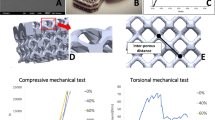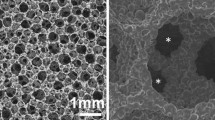Abstract
The functionality of a new metallic interbody fusion implant manufactured out of porous nitinol (PNT) was evaluated in sheep and compared to a conventional titanium (TiAIV) intervertebral cage packed with autologous iliac crest bone. Both device types were implanted at two non-contiguous intervertebral lumbar sites. The objective was to evaluate the osseointegration capacity after 3, 6 and 12 months of implantation in the presence of these two implant types subjected to the same mechanical loads. Two-dimensional radiology, computer tomography and histology were used as techniques of parameter evaluation. The results indicated that PNT obtained a better intervertebral osseointegration capacity compared to the TiAlV cage. The functional difficulties of the titanium implant were related to its instability at the implantation site possibly due to a biofunctionality problem. The biocompatibility of both implants seemed comparable, however.
Résumé
La fonctionnalité d’un nouvel implant métallique de fusion intervertébrale en nitinol poreux (PNT) a été évaluée chez la brebis, puis comparée à celle de la cage de fusion intervertébrale conventionnelle en titane (TiAlV). Le titane, contrairement au PNT, nécessitait une greffe osseuse à partir de la crête iliaque lors de l’implantation. L’objectif de ces recherches était d’évaluer, après 3, 6 et 12 mois postopératoires, la capacité ostéointégrative de ces deux types d’implants soumis aux mêmes sollicitations mécaniques du rachis à deux niveaux lombaires non-contigus. La radiologie bidimensionnelle, la tomographie et l’histologie furent utilisées comme techniques d’évaluation des paramètres d’intégration osseuse. Les résultats ont indiqué que le PNT, comparé au TiAlV, avait une meilleure capacité ostéointégrative. Les difficultés fonctionnelles du TiAlV étaient liées à son instabilité dans le site d’implantation, possiblement à cause d’un problème de biofonctionnalité. La biocompatibilité des deux implants semblait toutefois comparable.





Similar content being viewed by others
References
Butts MK, Kuslich SD, Bechold JE (1987) Biomechanical analysis of a new method for spinal interbody fixation. American Society of Mechanical Engineers, Boston
Chen L, Tang T, Yang H (2003) Complications associated with posterior lumbar interbody fusion using Bagby and Kuslich method for treatment of spondylolisthesis. Chin Med J 116:99–103
Christensen FB, Bunger CE (1997) Retrograde ejaculation after retroperitoneal lower interbody fusion. Int Orthop 21:176–180
Froum S, Cho SC, Rosenberg E, Rohrer M, Tarnow D (2002) Histological comparison of healing extraction sockets implanted with bioactive glass or demineralized freeze-dried bone allograft: a pilot study. J Periodontol 73:94–102
Hambly MF (1998) Lumbar interbody fusion utilizing fusion cages. West J Med 168:123–124
Harris WH (1995) The problem is osteolysis. Clin Orthop 311:46–53
Kim TI, Han JH, Lee IS, Lee KH, Shin MC, Choi BB (1997) New titanium alloys for biomaterials: a study of mechanical and corrosion properties and cytotoxicity. Bio Med Mat & Eng 7:253–263
Kuslich SD, Danielson G, Dowdle JD, Sherman J, Fredrickson B, Yuan H, et al (2000) Four-year follow-up results of lumbar spine arthrodesis using the Bagby and Kuslich lumbar fusion cage. Spine 25:2656–2662
Kuslich SD, Ulstrom CL, Griffith SL, Ahern JW, Dowdle JD (1998) The Bagby an Kuslich method of lumbar interbody fusion. History, techniques, and 2-years follow-up results of a United States prospective, multicenter trial. Spine 23:1267–1279
Lumbikanonda N, Sammons R (2001) Bone cell attachment to dental implants of different surface characteristics. J Oral Maxillofac Implants 16:627–636
Meraw SJ, Reeve CM, Wollan PC (1999) Use of alendronate in peri-implant defect regeneration. J Periodontol 70:151–158
Mulholland RC (2000) Cages: outcome and complications. Eur Spine J 9(Suppl 1):110–113
Murdoch DR, Roberts SA, Fowler VG Jr, Shah MA, Taylor SL, Morris AJ, Corey GR (2001) Infection of orthopedic prostheses after staphylococcus aureus bacteremia. Clin Infect Dis 32:647–649
Papastefanou SL, Stevens K, Mullholand RC (1994) Femoral nerve palsy. An unusual complication of anterior lumbar interbody fusion. Spine 19:2842–2844
Rhalmi S, Tabrizian M, Odin M, Assad M, Yahia L.H, Rivard CH (1999) Hard, soft tissue and in vitro cell response to porous nickel-titanium: a biocompatibility evaluation. Bio-Med Mat & Eng. 9:151–162
Steflik DE, Corpe RS, Young TR, Sisk AL, Parr GR (1999) The biologic tissue responses to uncoated and coated implanted biomaterials. Adv Dent Res 13:27–33
Thierry B, Tabrizian M, Trepanier C, Savadogo O, Yahia L (2000) Effect of surface treatment and sterilisation process on the corrosion behavior of NiTi shape memory alloy. J Biomed Mater Res 51:685–693
Wever DJ, Veldhuizen AG, Sanders MM, Schakenraad JM, Van Horn JR (1997) Cytotoxic, allergic and genotoxic activity of a nickel-titanium alloy. Biomaterials 18:1115–1120
Acknowledgement
The authors would like to thank Mrs. Sylvie Charette for her excellent assistance throughout animal implantation and necropsy.
Author information
Authors and Affiliations
Corresponding author
Rights and permissions
About this article
Cite this article
Likibi, F., Assad, M., Jarzem, P. et al. Osseointegration study of porous nitinol versus titanium orthopaedic implants. Eur J Orthop Surg Traumatol 14, 209–213 (2004). https://doi.org/10.1007/s00590-004-0176-8
Received:
Accepted:
Published:
Issue Date:
DOI: https://doi.org/10.1007/s00590-004-0176-8




